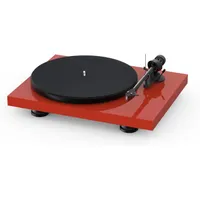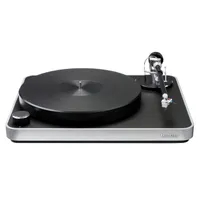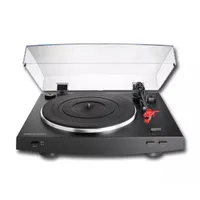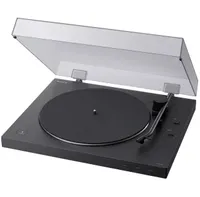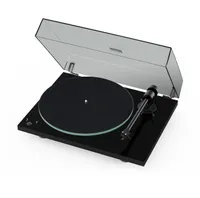Best record players 2025: Top-flight turntables for every price bracket
Don’t know what record player to buy? I’ve collected a shortlist of my favourite turntables available today, from affordable automatics to hi-end, hi-fi highlights

The record player is a fundamental tool in any hi-fi arsenal, whether you’re a passive collector of charity-shop prog records or a Record Store Day-queuing veteran. Vinyls (and yes, that’s the plural) are far more than collectible curios or display decorations; they are stores of immense creative value, from the songs themselves to the bespoke mastering they receive to work in this wondrous physical format. And they deserve to sound their best - and that's where buying one of the best record players comes into play.
Picking a turntable – whether it’s your first, your next or someone else’s first – is a crucially important endeavour. There’s so much to consider, from basic build quality and adjustability to the features and fittings you may want or need. In a market so full of excellent options, how are you to choose?
I’ve handpicked several of my favourite record players from across the market, including accessibly-affordable beginner turntables and premium-quality, premium-priced record players. Somewhere in this list is your next turntable.
I will caveat that this piece is a little biased, towards turntables at the cheaper end of the price spectrum – though bear in mind this does reach up to price points equivalent to a new car. If you’re looking for some tried-and-tested options as a starter turntable or as a turntable upgrade; if you’re willing to spend thousands, you probably don’t need my advice!
For those that do, though – whether you want to know your manuals from your automatics, or precisely how a turntable cartridge actually works – you’ll find a FAQ section and glossary below, stacked full of info and pointers on this very nerdy little niche. If you just want to listen to that charity shop Focus record, read on to find out my picks for the best record players in 2025.
But if you're eager to get started, I'll give you my top two picks - and you'll find out more details on both of these turntables below. My top choice goes to the Rega Planar 3 - a record player that oozes style and sounds even better than it looks. My second pick goes to a turntable from the ever-dependable Audio-Technica in the shape of the AT-LP70XBT. It's a two-speed, beginner-friendly unit that won't disappoint - and it also features in our guide to the best Audio-Technica turntables.
Score huge savings on turntables and wax with our pick of the best Black Friday record player deals and Black Friday vinyl deals.
Out top picks
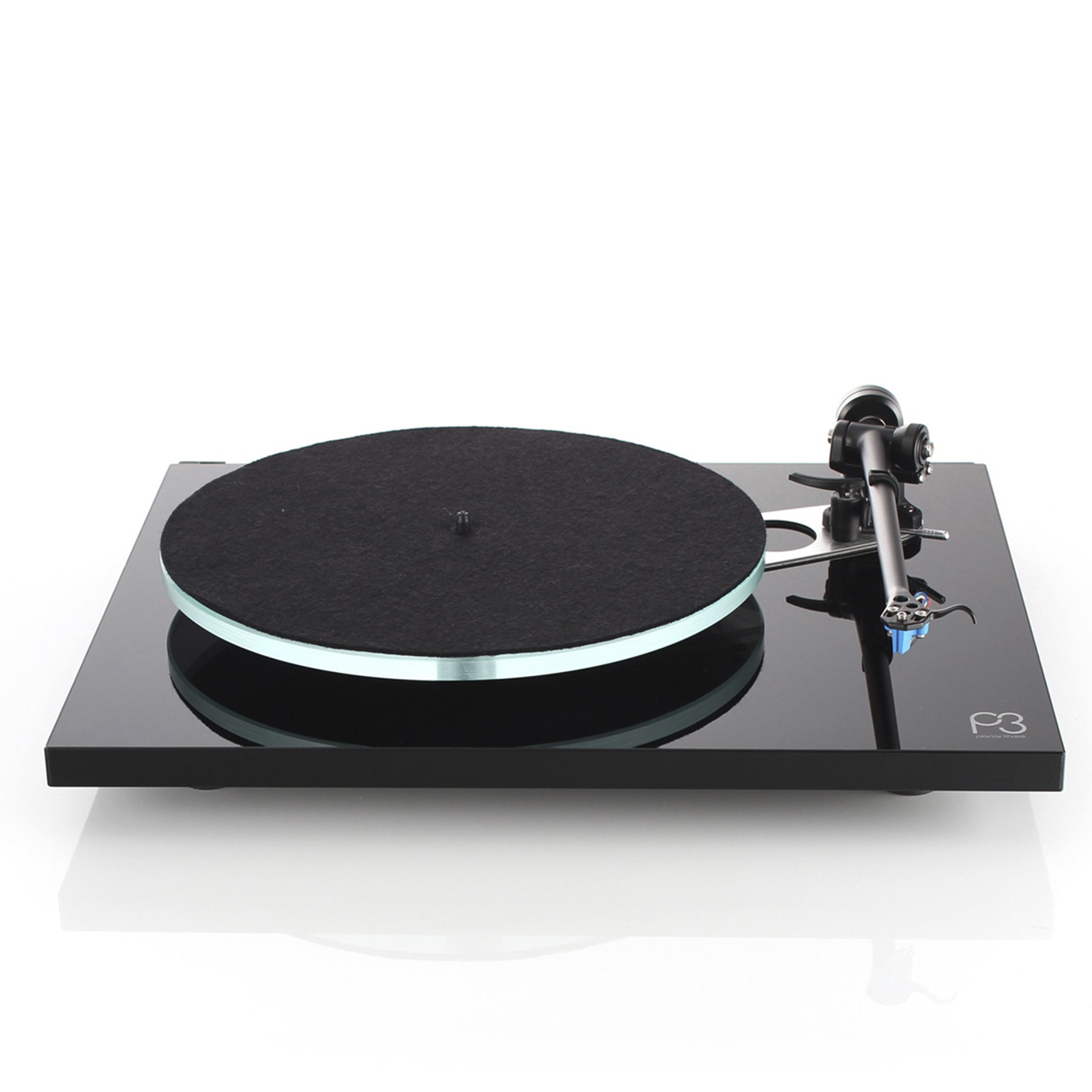
This Rega turntable is an unbelievably clean and clear performer that doesn’t impart its own character on your record collection. Everything you throw at it will sound just as it should – packed with detail, punch, rhythm and impeccable tonality. If you want to hear your vinyl as it was intended, this is how you should do it. Our top pick is simply awesome.
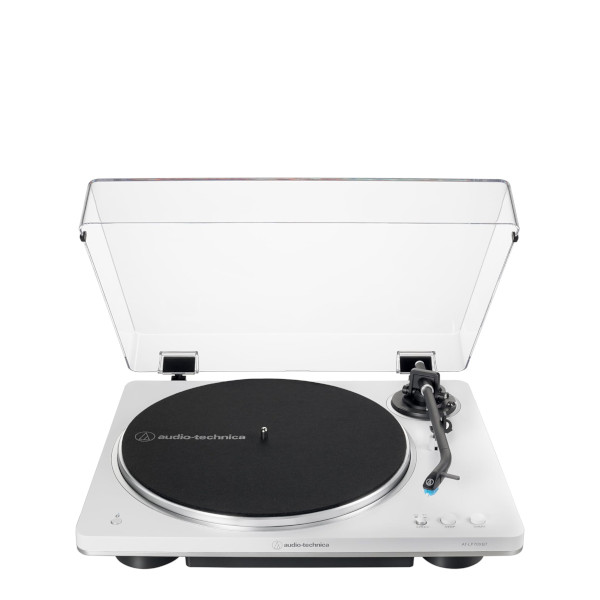
If you're in the market for a great-sounding, beginner-friendly turntable, then I recommend the Audio-Technica LP70XBT. This two-speed, automatic record player is easy to use and, should you wish to replace the stylus in the future, you can - a feature many entry-level turntables don't offer. For the price, you get a lot for your money.
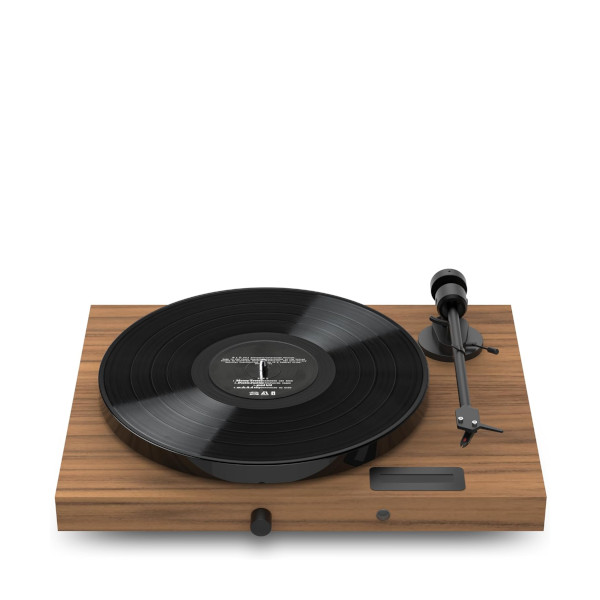
The Pro-Ject Juke Box E1 is a do-it-all turntable that nails the brief. A built-in phono stage and amplifier means all you need add is a pair of speakers – and two-way Bluetooth connectivity sweetens the deal, allowing you to use the built-in amp for streaming audio, or for beaming your wax to your favourite Bluetooth speaker. Add Pro-Ject’s hallmark build quality, and you’ve got a Swiss-army-knife winner in the making.
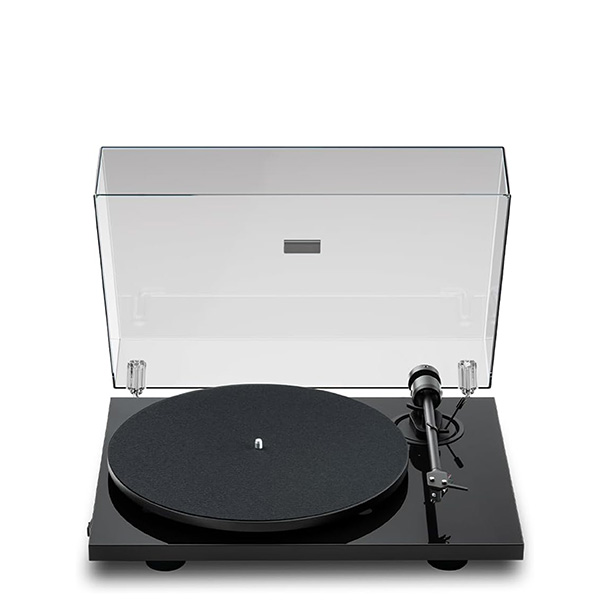
Pro-Ject’s latest beginner record player continues the manufacturer’s rich tradition of excellent hi-fi at low prices. The E1.2 is a manual turntable with a fab Pick-it cartridge, a heavy platter and Pro-Ject’s trademark minimalism on full display; it’s a perfect budget option for the burgeoning enthusiast.
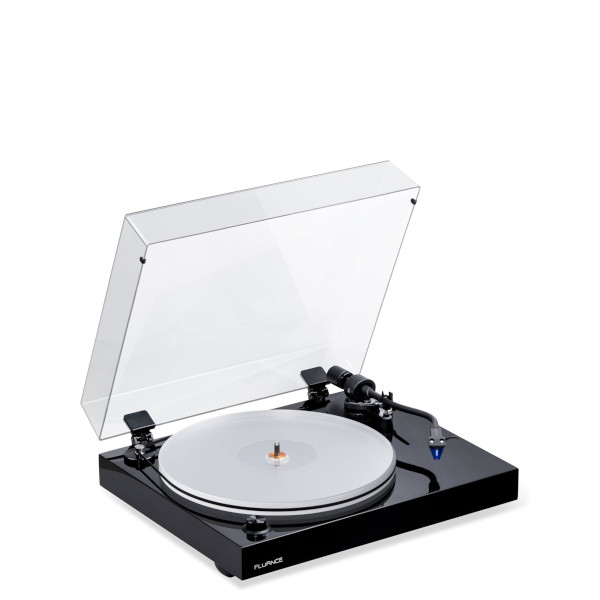
Fluance turntables inhabit a comfortable space between beginner-friendly players and audiophile units. The RT85 has a brilliant Ortofon 2M Blue cartridge, while the whole unit is rock-solid thanks to its acrylic platter. The Fluance RT85 is also available in a range of colour variations, making it a top-quality turntable.
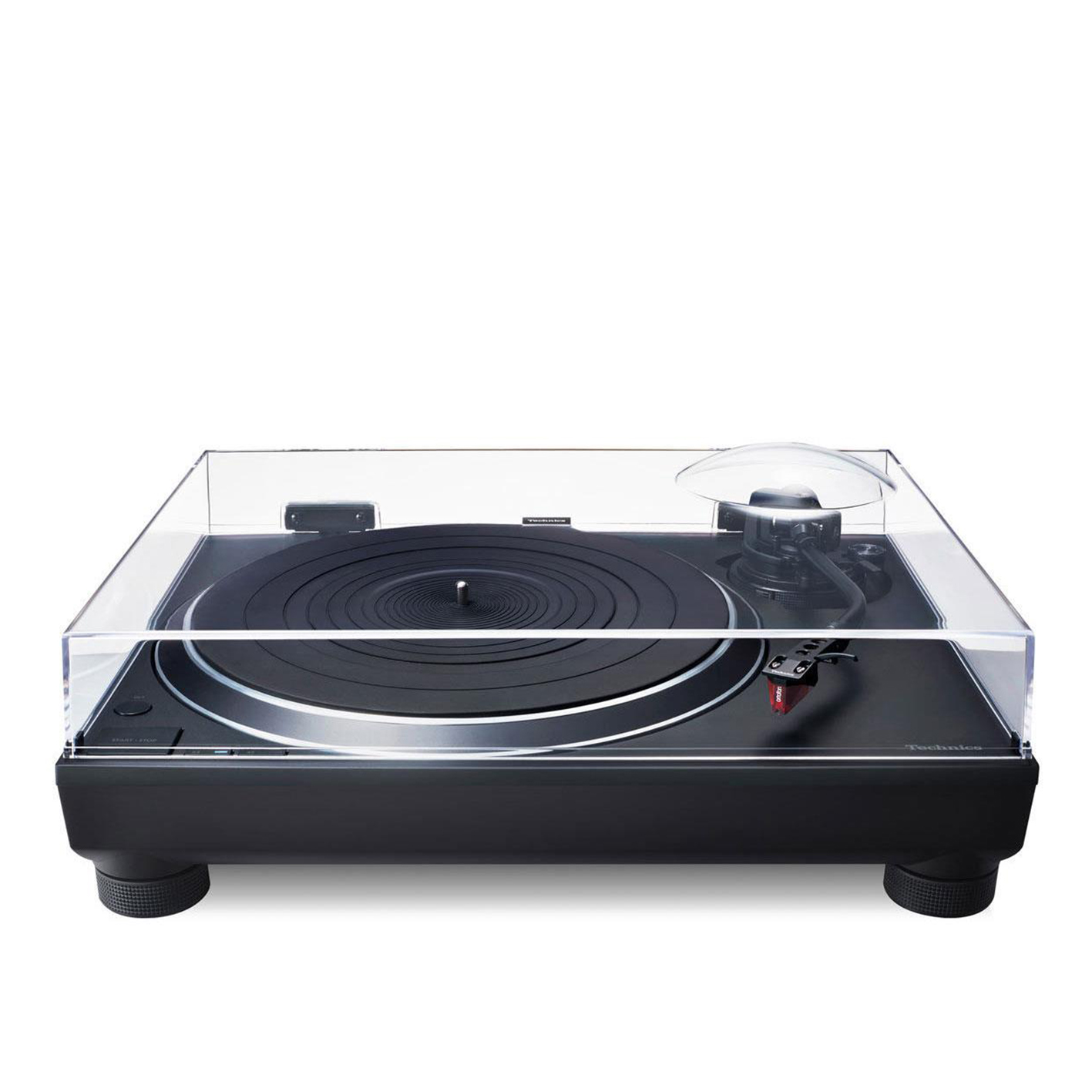
This Technics turntable is a thoroughly modern unit with direct drive, so there's no belt to mess about with. What’s most impressive is how amazing the SL-1500C sounds. Clean, organised and dynamic, it takes a digital approach that digs up all of the detail, but it’s not cold and unfeeling in the way of a hi-res music player.
Best overall
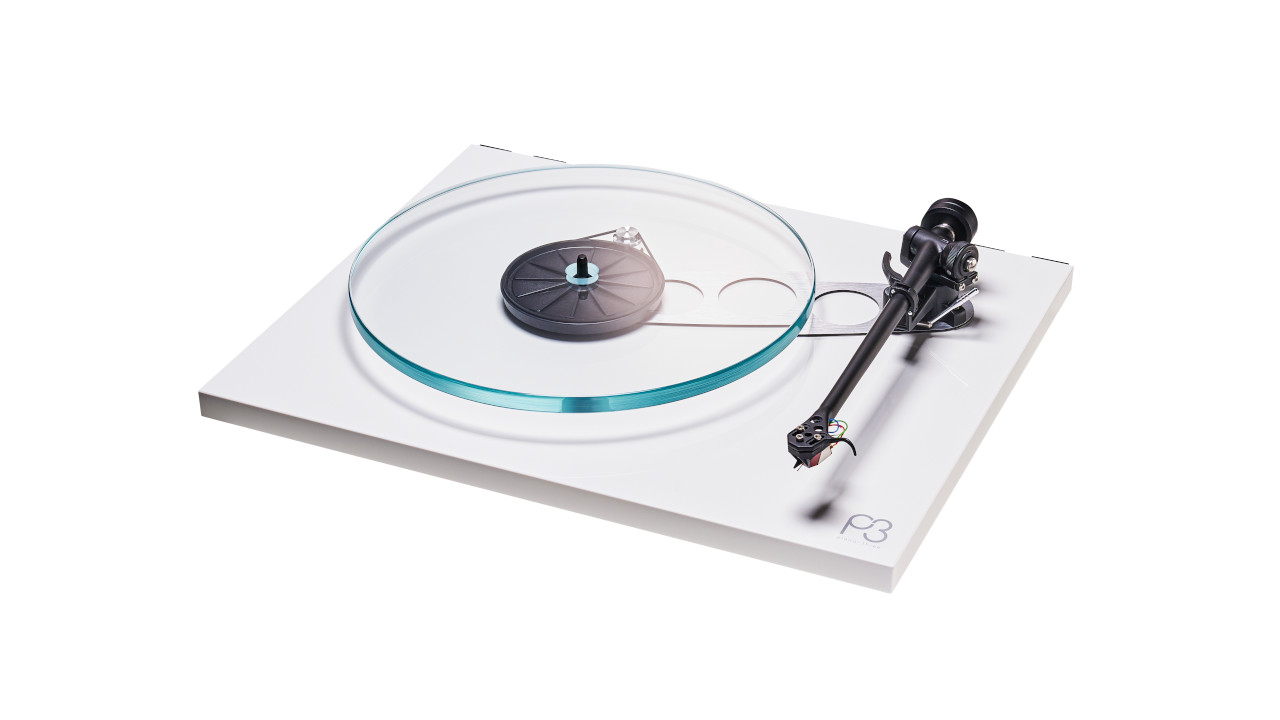
Specifications
Reasons to buy
Reasons to avoid
✅ Buy if you want a top turntable that looks the part: This is a solid, belt-driven turntable that will play your records in all their glory.
❌ Avoid if you want Bluetooth functionality: This is a brilliant turntable, but if you want Bluetooth capabilities, you’ll have to look elsewhere.
Sound: ★★★★★
Design: ★★★★★
Features: ★★★★
Overall: ★★★★★
The original Planar 3 is now more than 40 years old. Yet, amazingly, if I was to put it and this current version side-by-side, I think most people would be hard-pressed to spot any differences beyond the smarter plinth and updated tonearm.
Under the skin, almost every part had been revised since the last version – the P3-24 and yet the core character remains. I found this Rega turntable to be an unbelievably clean and clear performer that doesn’t impart its own character on your records. Everything you throw at it will sound just as it should – packed with detail, punch, rhythm and impeccable tonality.
You can also buy the Rega Planar 3 with added Elys 2 moving magnet cartridge, which will add a handful of cash to the purchase, but I only think the extra outlay is worth it if you're looking for absolutely top-drawer performance and crystal clear audio.
If you want to hear your vinyl as intended, this is how you should do it. In my opinion, this is the best record player around right now, bar none.

"I didn't think the Planar 3 could get much better at this price, but how wrong I was. Following a near-complete overhaul, Rega's legendary turntable sounds more detailed, more lively and more organised than ever."
Read more: Rega Planar 3 review
Best beginner
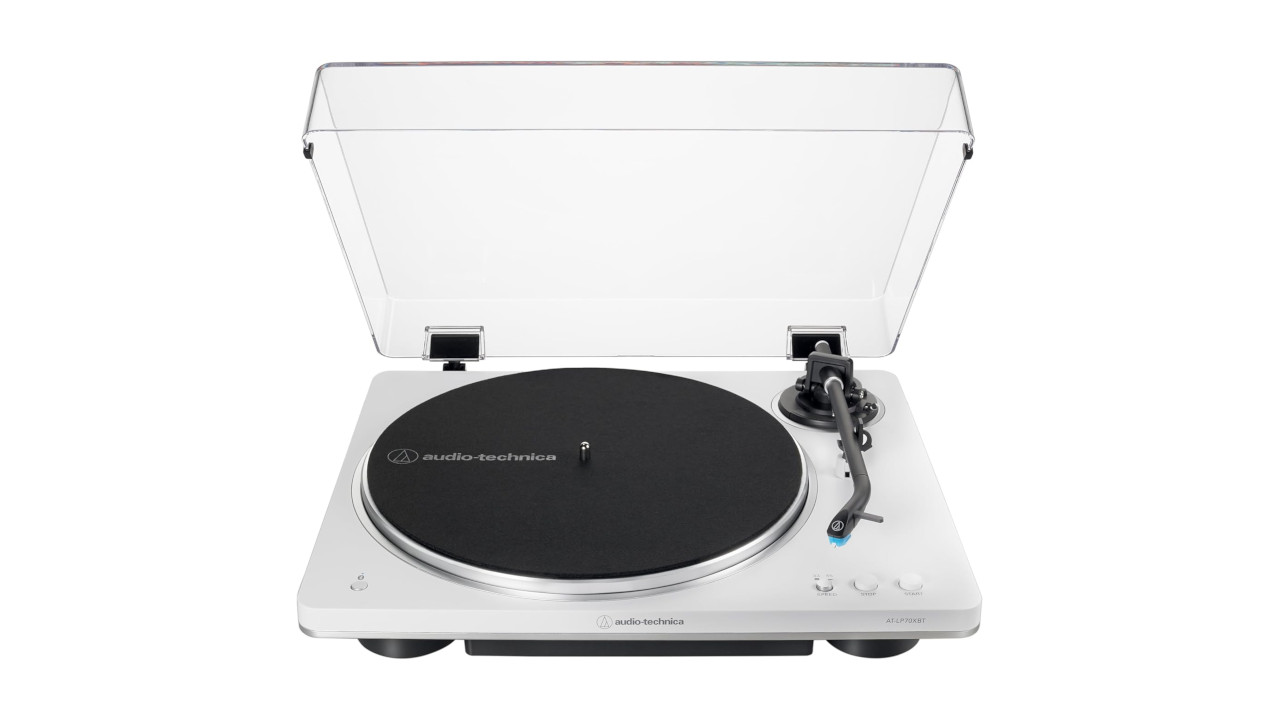
Specifications
Reasons to buy
Reasons to avoid
✅ Buy if you want a top automatic unit with Bluetooth: This is an excellent option for first-time buyers, with the LP70XBT turning out great sound... and it has Bluetooth.
❌ Avoid if you have a little more to spend: There are better Audio-Technica models available that’ll better suit more experienced vinyl fans.
Sound: ★★★★
Design: ★★★★
Features: ★★★★½
Overall: ★★★★
Audio Technica’s latest beginner-friendly turntable is something of a winner, and in quite a few respects as well. The AT-LP70XBT is the successor model to the LP60XBT, a hugely popular automatic turntable which no doubt has served as a great many people’s first-ever turntable; the LP70XBT takes the essential format and runs with it, resulting in one of the best low-budget turntables on the market today.
Most conventional turntables have removable cartridges, enabling users to replace them with their own or as styli wear down; entry-level turntables often don’t have these, instead hardwiring an inexpensive assembly into the tonearm. The LP70XBT does the best of both worlds, by using Audio-Technica’s new(ish) VM95 series standard for its stylus. It ships with the AT-VM95C stylus, a conical stylus with solid and serviceable fidelity – but you can upgrade it to another in the series at your leisure, and with as much simplicity as operating the turntable itself.
There’s a great deal to love about the AT-LP70XBT. It does a lot of things right that other entry-level turntables don’t, from stable playback to princely treatment of the records you play on it. There are some essential sound- and build-quality trade-offs that come with the price, but as far as budget beginner record players go, this is the bee’s knees.
Best all-in-one
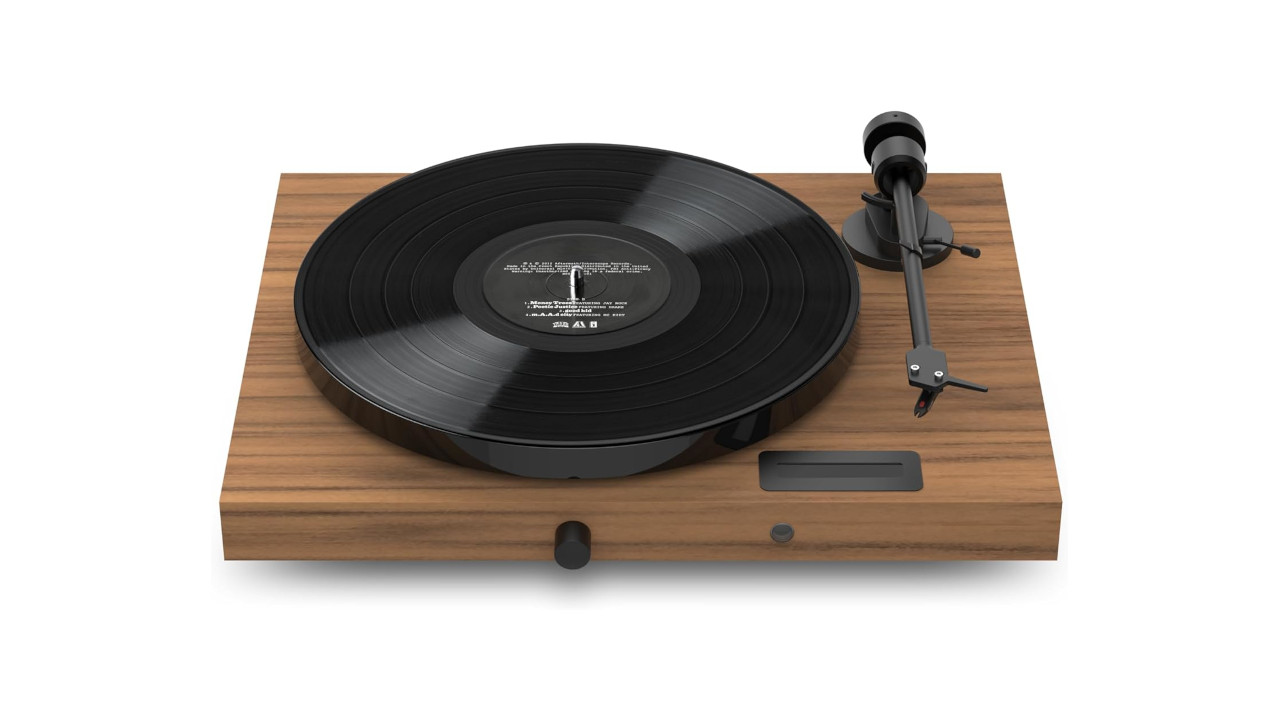
Specifications
Reasons to buy
Reasons to avoid
✅ Buy if you want an easy to set up turntable: Project’s offerings are always worth a closer look, and with built-in phono stage and amp, all you need to add is a pair of speakers
❌ Avoid if you’re on a tight budget: All the E1’s bells and whistles means you’re going to have to pay a bit extra to get your hands on one.
Sound: ★★★★½
Design: ★★★★
Features: ★★★★½
Overall: ★★★★½
Pro-Ject’s Juke Box E1 stands apart from myriad products with which it shares a niche. A great many all-in-one turntables are budget fare, cramming fairly-decent amps and speakers into a big chassis with a disappointing turntable atop; the Juke Box E1 dares to dream of a world in which convenience and quality really, actually, truly share a body.
This all-in-one turntable pairs an excellent record player, based on the Pro-Ject Primary E turntable, with a phono stage and a capable 50W stereo amplifier. The Ortofon OM 5E cartridge it comes with is a cut or three above other budget cartridges on similarly-designed systems, too. All you need to be prepared to add is a pair of decent speakers – which Pro-Ject are even prepared to provide as a bundle, if you opt to pay a little more.
Not only does the Juke Box E1 simplify the sometimes-arcane process of putting together a hi-fi system, but it brings yet more techy convenience by way of bi-directional Bluetooth connectivity.
You can stream audio to your turntable, or stream vinyl audio from it to your Bluetooth-enabled destination of choice. These possibilities are no longer new, but they are a delight to engage with in a sleek, well-built Pro-Ject chassis.
Best budget
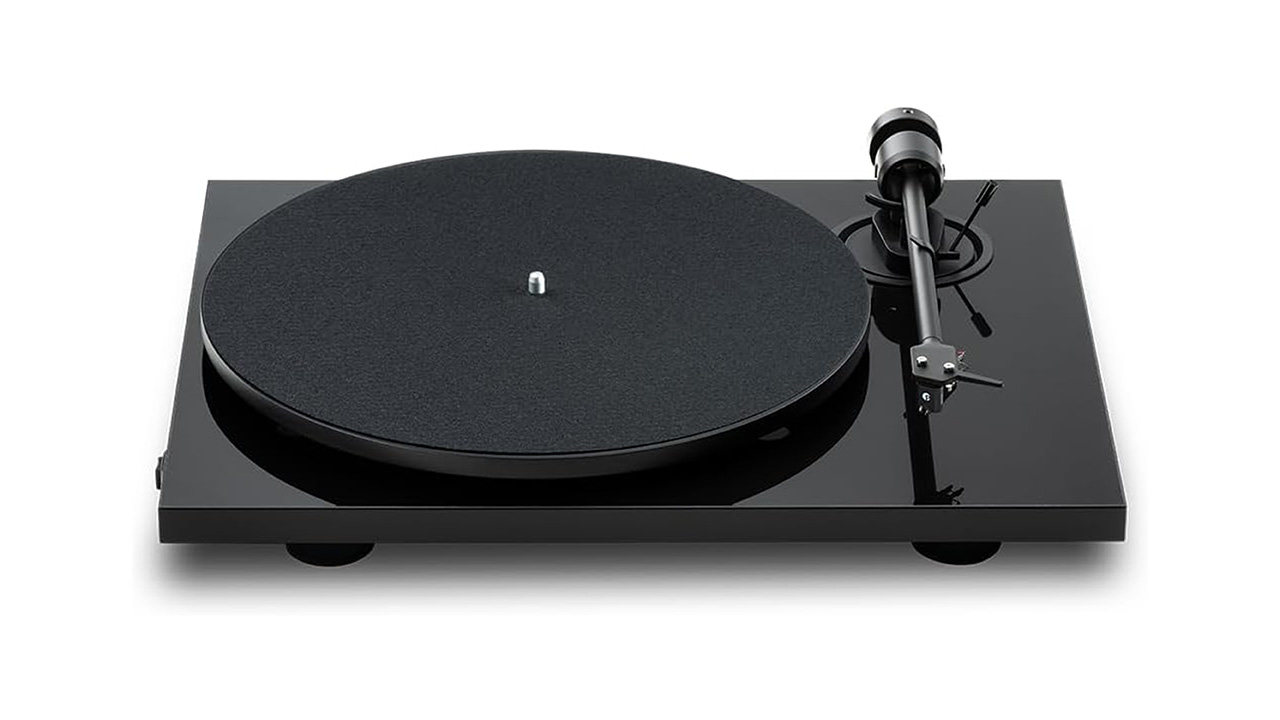
4. Pro-Ject E1.2
Our expert review:
Specifications
Reasons to buy
Reasons to avoid
✅ Buy if you want a great first record player: With a great build quality and a top sound, this is a starter record player you won’t need to upgrade for a while.
❌ Avoid if you don’t want to build a full hi-fi stack: You’ll need a separate phono preamp to make the most of this record player.
Sound: ★★★★½
Design: ★★★★
Features: ★★★★
Overall: ★★★★½
Pro-Ject is a common feature of best-of guides like this, thanks to its incredible consistency across the price spectrum; if it’s Pro-Ject, it’s going to be decent. When so many budget record players fall short of the mark, getting something affordable and good is harder than it should be. For a budget start to an excellent hi-fi setup, Pro-Ject’s E1.2 is the new best-in-class.
Where other budget record players tend to compromise on some essential aspects of what makes a good record player, Pro-Ject does a phenomenal job of hiding its own compromises behind some impressive results. The E1.2 ships with a great moving-magnet cartridge from Pro-Ject’s in-house brand Pick-it – which renders your records with glorious clarity and width. The heavy aluminium platter lends assured steadiness to its performance, just as that smooth minimalist design leads assured suavity to the room.
The E1.2 is an excellent starting-point record player, for its quality and for the fact it arrives perfectly set-up for immediate use. However, if you haven’t already, you’ll need to buy hi-fi separates to use it properly – including a phono preamp, which many other affordable record players come pre-quipped with. If you’re prepared to make the most of your record-playing opportunity, this could be a budget-friendly excuse to start on the right foot.
Best mid-price
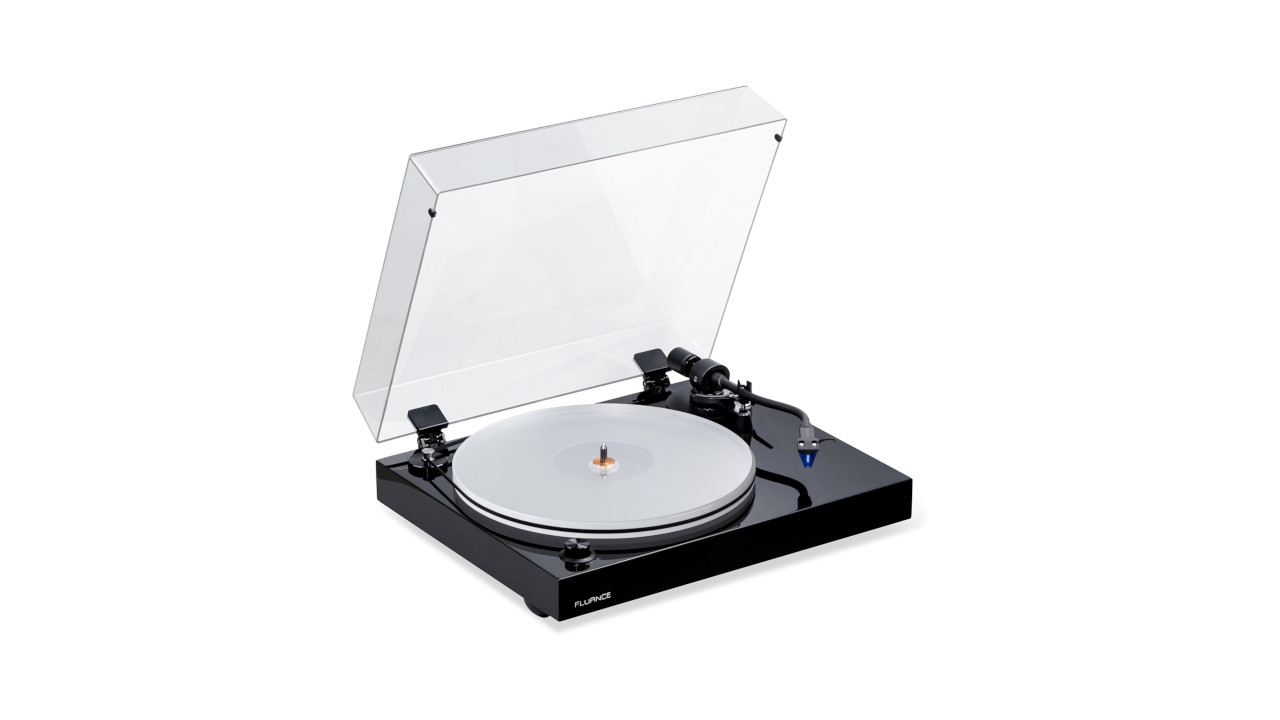
5. Fluance RT85
Our expert review:
Specifications
Reasons to buy
Reasons to avoid
✅ Buy if you want a no-nonsense & robust player: This is a no-frills record player but it’s well-built and has a phono stage.
❌ Avoid if you looks matter in your tech: As solid as it is, the RT85 isn’t the most eye-catching piece of tech out there. Not that should really matter, but still.
Sound: ★★★★
Design: ★★★½
Features: ★★★★
Overall: ★★★★
If you ever go to the wider turntable community for advice on picking out a good ‘next’ turntable, you’ll hear the name Fluance a whole lot. Fluance turntables are rightfully vaunted as next-step record players for vinyl converts digging into their hi-fi journey, bridging perfectly as they do the gap between entry-level players and the audiophile hi-fi market – and the Fluance RT85 is a fab example.
The RT85 boasts an excellent Ortofon 2M Blue cartridge, which rules the roost among stock moving magnet cartridges for dynamic range; it’s fitted to a well-designed S-shaped tonearm, so-shaped to improve tracking and look good doing so. The RT85 also benefits from a big fat acrylic platter, which adds weight and stability to the whole shebang.
It helps too that the RT85 is a highly attractive object, with four possible finishes (including Piano Black and an irresistibly executive ‘Walnut’) and the shrewd flourish that is the external belt-drive system. Whether you’re looking for an on-ramp to quality hi-fi from the shonky depths of the sub-£100 suitcase turntable (shudder), or simply looking for a dependable record player you can hang on to for a while, this is an excellent choice for you.
Most durable
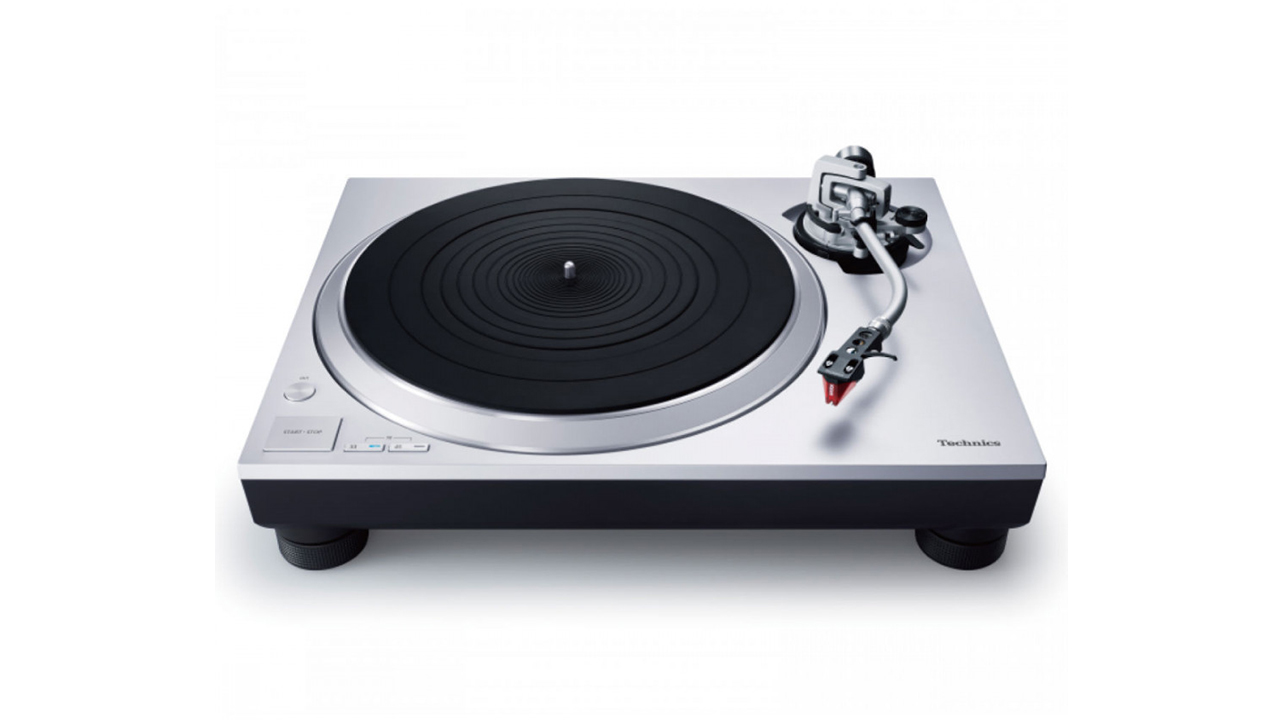
6. Technics SL-1500C
Our expert review:
Specifications
Reasons to buy
Reasons to avoid
✅ Buy if you want a solid mid-price performer: If you’re looking to move your starter unit to the next level, the belt-driven Fluance RT85 has you covered.
❌ Avoid if you need a few more extras: The Fluance RT85 has no Bluetooth, USB recording or built-in phono stage - just 3 things to bear in mind before you buy.
Sound: ★★★★
Design: ★★★½
Features: ★★★
Overall: ★★★★
This Technics turntable is a thoroughly modern unit with direct drive - so there's no belt to mess about with - a built-in cartridge and integrated phono preamp.
It’s also semi-automatic, so while you have to place the stylus in the groove to begin with, the tonearm will lift from the record at the end without you needing to lift a finger.
But what I found most impressive about this next-gen turntable is how amazing the SL-1500C sounds. Clean, organised and dynamic, it takes a digital approach that digs up all of the detail on that big, black slab, but it’s not cold and unfeeling in the way of a hi-res music player.
In short, it’s as straightforward as vinyl gets and it sounds amazing. If you’ve got a grand to drop on your analogue habit, this is the best record player to spend it on.
And if you're looking for a turntable that will last you years - representing incredible value for money - the Technics is hard to beat.

"Spending this amount for an entry-level turntable sounds expensive, but then this is no ordinary entry-level turntable. From top to bottom, the SL-1500C oozes the kind of quality that Technics is renowned for. If you're serious about vinyl, it should definitely be on your shortlist."
Read more: Technics SL-1500C review
Also tested
The above record players are for us, the ones you should be spending your money on. That said, they aren't the only ones we've reviewed. So if you don't see what you're looking for above, here is a selection of other record players we've reviewed.
Pro-Ject Debut Carbon Evo ★★★★★
The best for sound and style in one neat little package
It’s priced in a similar bracket to the Pro-Ject Juke Box E that sits at #3 in this guide, but this one comes with an easy rocker switch for changing speeds, plus improved suspension for better playback stability. I also think it looks the part thanks to its stylish and sleek design.
Read more: Pro-Ject Debut Carbon EVO review
Clearaudio Concept ★★★★½
For great all-round performance
Simplicity is a big part of this package’s charm: it's a 'plug and play' product straight out the box. I really can’t see anyone turning down the Clearaudio Concept for a lack of talent. It's as clean, rhythmic, detailed and spacious as you’ll find for the money, not to mention engaging and entertaining.
Read more: Clearaudio Concept review
Audio-Technica AT-LP3 ★★★★★
A great record player for automatic operation at a low price
The Audio-Technica AT-LP3 has a completely automatic action – start the record at the touch of a button and finish it without lifting a finger – and sounds downright excellent for the money, with a balanced, natural sound that doesn’t mask your tune of choice.
Read more: Audio-Technica AT-LP3 review
Sony PS-LX310BT ★★★★★
Easy to set up, fully automatic Bluetooth deck
If you’re looking to marry old-school hi-fi with new-school cool, this Sony spinner is the best record player for you in my opinion. The big draw is Bluetooth support, which you can use to send that rich, analogue audio via the digital, wireless domain to a pair of Bluetooth headphones or a wireless speaker. Crucially, the PS-LX310BT record player also sounds great.
Read more: Sony PS-LX310BT review
Pro-Ject T1 ★★★★½
An 'audiophile entry-level turntable' that's practically plastic-free
If you want your affordable record player to have a premium look and feel then Pro-Ject turntables are definitely worth your consideration, and specifically the Pro-ject T1. This entirely plastic-free deck is completely solid and weighty, and it comes more or less ready to rock straight out of the box – you need only place the platter and belt yourself.
Read more: Pro-Ject T1 review
Glossary
33 ⅓rpm / 45rpm / 78rpm
Vinyl records are played at either 33 ⅓ or 45rpm (revolutions per minute); some records, particularly older phonograph records, play at 78rpm. Record players allow you to switch the speed at which the platter rotates, so you can hear the record at its correct pitch.
Anti-skate
Anti-skate is a mechanism that counteracts the centripetal force experienced by the cartridge while the record plays. Without it, the stylus can push against one side of the record’s groove more than the other, creating an unbalanced sound, distortion, and even damage.
Belt drive
Belt drive record players rotate their platter with a belt, attached to a small motor via a pulley. Most entry-level record players are belt drive, as the assembly is cheaper than direct drive; however, belt drive systems are less noisy than the alternative, and can also run smoother.
Cartridge
The cartridge is the assembly at the end of your record player’s tonearm, which converts mechanical vibrations from the grooves in your vinyl record into electrical signals via the stylus. There are two types of cartridge: moving magnet (MM), and moving coil (MC). MM cartridges are more affordable, and far more common as the supplied cartridge with turntables; MC cartridges are more expensive, and offer a higher fidelity at the expense of less volume.
Direct drive
Direct drive turntables have a motor which directly turns the platter. This direct control provides better torque and stability, which makes direct drive record players an asset for DJs; the trade-off is more self-noise, which may not be ideal for home hi-fi rigs.
Line/line level
Line level is a standardised strength of audio signal shared between types of audio equipment. It is the output level of a phono preamp stage, or of some record players with a built-in phono stage – and the level your hi-fi amplifier expects to receive.
Phono preamp
The phono preamp is a pre-amplification stage in a record player hi-fi setup; it boosts the minute signal produced by the cartridge, to prepare it for further amplification by the hi-fi amp. Some record players come with this stage built-in for easier setup, but a separate phono stage is often better for controlling the quality of your hi-fi results.
Platter
The platter is the rotating plinth on which your vinyl records sit; it is either rotated directly by a direct-drive motor, or as part of a belt-drive mechanism. Platter design and weight both matter for the performance of the record player; heavier platters tend to result in smoother, more controlled rotation.
Stylus
The stylus is the pin at the end of your record player’s cartridge, which follows the groove of your record and interprets its ridges as vibrations. Styli come in different shapes, with different benefits for the resulting sounds.
Tonearm
The tonearm is the pivoting arm that enables a record player’s stylus to follow the groove from outside in.
Wow and flutter
Wow and flutter is one of the variables that determines the capability of a given record player; it describes the consistency of speed at which a record player plays, and can be affected by the quality of the motor assembly, the construction of the platter or the condition of the stylus. Wow is when a record’s pitch varies once per revolution, and flutter is when pitch varies repeatedly during a single revolution.
How to choose the best record player for you
So, you've decided to pull the trigger and purchase a shiny new record player, but what are the key elements to consider before laying down your hard-earned cash?
It might sound obvious but sound quality is the biggest priority by far. While no audio firm has a completely perfect record in this area, sticking to the established and well-respected brands is a great place to start.
There are certainly some flagship brands to keep an eye out for. While our pick for best record player overall is made by Rega, don't forget about Pro-Ject which also boasts an accomplished range, while Technics and Clearaudio dominate the high-end record player sector. Sony and Audio-Technica, meanwhile, are particularly good at pairing true hi-fi audio quality with modern features such as Bluetooth and USB recording. We'd also recommend you take a look at our dedicated guide to the best Audio-Technica turntables.
It's also important to put some thought into whether you’ll actually use those kinds of high-tech features. While it’s nice to have lots of options at your fingertips, don’t splash out on tech you'll never use, as you could save yourself a bit of cash. If in doubt, remember this: the techiest turntable is almost never the one that sounds the best.
FAQs

What makes a good record player?
Record players are deceptively simple things – and yet, a good record player is an undeniably special thing. The market is flooded with cheap and accessible turntables, which can make it harder to discern between the best and the rest. There are some basic features, though, that can help you make your decision.
A good record player doesn’t just sound good; it treats your records with care and respect (which, incidentally, contributes to the whole “sounding good” thing). A record player is more likely to be able to do this if it has an adjustable counterweight, an anti-skate mechanism, and the option for you to remove and replace the cartridge.
There are exceptions to this rule – most notably the Audio-Technica AT-LP70X, which has an integrated AT-VM95 cartridge chassis (that still allows you to swap styli) and a pre-set counterweight for record-friendly plug-and-play. Still, for a turntable you can reasonably trust with the sanctity of your now-priceless vintage Black Sabbath collection, you should look for adjustability first.
One of the other variables you’ll encounter between record players is wow and flutter – which describes minor variations in speed either within a single revolution of the record, or per revolution.
Cheaper record players, with lighter chassis and platters or with a middling speed control system, are more likely to be a bit pitchy when playing back your records; meanwhile, better players will have a heavier platter, stronger motor and more precise pitch control.
Do I need speakers for my record player?
To get sound from a vinyl record, you need three things: a record player, an amplifier stage, and speakers. Some budget turntables are all-in-one affairs, that come with everything built-in. Some of these are Bluetooth-compatible, and some are even portable record players, happy playing your faves out and about.
Suitable as such an all-in-one record players may be for occasional, passive listening or the teenage bedroom, there’s a reason that you won’t find them in my guide to the best record players. Simply put, the vast majority of them aren’t good enough for the home listening experience you deserve.
For something that treats your records well and sounds good doing so, you’re better off investing in good separates – which means purchasing a dedicated set of turntable speakers to go with your hi-fi amp. You may need some additional components too, including a separate phono preamp. Speaking of which…
Do I need a phono preamp for my record player?
A phono preamp is a stage of pre-amplification that goes between the record player and your hi-fi amplifier; the signal produced by your record player’s stylus is minute, and needs some initial conditioning before it can be boosted properly into your speakers.
Many record players, particularly those towards the budget end of the price spectrum, have an integrated phono preamp. This means they can be plugged straight into a hi-fi amp without the need for an extra stage. Conventionally, though, and with most standalone manual record players, you’re expected to get a phono stage of your own (if your hi-fi amp doesn’t have its own integrated phono stage, which some do).
If you’re buying a record player with a phono preamp built in, you won’t need to buy a separate one. If you can’t tell from the specs, look at the back and see if the RCA outputs are labelled ‘phono’ or ‘line’. If it’s ‘phono’, you’ll need a phono stage; if it’s ‘line’, you won’t.
If your record player of choice has both, or the option to switch the phono stage off, I’d recommend you consider getting one anyway! The phono stage can do a lot of good for your listening experience, and having more control over it can only be a good thing for the quality of your rig.
Are record players easy to set up?
Some cheaper record players are very easy to set up, to the point that they are pretty much plug-and-play – whether fully all-in-one listening stations or simply pre-calibrated turntables with a line level output for your amp. Conventionally, though, your record-player-toting hi-fi requires some assembly.
The four stages for a working record player hi-fi system are: a record player; a phono preamp; a hi-fi amplifier; and a set of speakers. Some turntables have some of these stages built-in – the Pro-Ject Juke Box E1 going as far as to have the phono preamp and hi-fi amp integrated, meaning you need just the speakers to make it work. Most record players you’ll encounter are either just a record player, or have a built-in phono stage for convenience. As such, generally speaking you’ll need to connect your turntable to an amplifier with speakers at least.
There’s also the matter of ensuring the turntable itself is properly set up, and able to play your records without sounding awful – or worse, damaging them. Again, entry-level plug-and-play automatic turntables are often pre-calibrated right out of the box, albeit not the most trustworthy with prized records. The further up the turntable food chain you get, though, the more adjustability and customisability you encounter.
Think of the record player itself as three components: the cartridge, that picks up vibrations from a vinyl record and converts them to electricity; the tonearm, that holds the cartridge and allows it to move inward with the record’s groove; and the platter, that spins the record.
Properly setting up a record player tends to involve calibration of the first two, from counterweighting the tonearm for best sound and minimal damage to adjusting the positioning of the cartridge. We go into more detail on how to properly set up a record player.
How much money should I spend on a record player?
The only real answer as to how much you should spend on a record player is “however much you’re comfortable with”. There are excellent models available at every price point, as evidenced by this very list! Of course, the more you spend, the better returns you get in terms of build quality and sound fidelity. As such, it might help to figure out which budget range you’re comfortable looking in.
If you’re going truly budget, then you can pick something up for up to around the $/£150 mark. Anywhere from $/£200-400 and you’ll be comfortably into territory where the components are better, the sound starts to improve and you’ll get an extra dollop of style. Above $/500, and you’ll find yourself starting to split hairs over what matters to you features-wise.
Truth be told, that £/$200-400 lower-middle range is the sweet spot for most budgets, and where you’ll find the most competition between lauded turntable brands. Just make sure you have your list of must-haves to hand before you start narrowing down to your preferred price. You may find yourself paying a little extra for quality turntables with features such as Bluetooth and USB connectivity.
If you do have a little more to spend, though, you’ll find yourself comfortably in the realms of a deck that delivers premium components, exceedingly stable playback and robust build quality. Whatever you buy, with the right money behind it and the right research, will be sure to last.
Do I need a cartridge for my record player?
Most record players will come with a cartridge pre-installed, meaning you do not need to buy your own straight away. Some more expensive record players may come without a cartridge, but all the record players in my list are pre-adorned with something to play your records with.
That said, the cartridge is arguably the most responsible for the quality of sound coming from your turntable – and investing in an upgrade could be a cost-effective way to get even more out of your system. Replacing your cartridge is relatively easy (if a little fiddly), provided your turntable doesn’t have an integrated cartridge system – a common feature of entry-level turntables.
What should I look for in a record player?
What you should look for in a record player depends on what you need in your hi-fi. You might want a simple, plug-and-play turntable that can cast audio to a Bluetooth speaker, for a fuss-free setup; here, a quality automatic turntable with Bluetooth transmission would be ideal, provided it had at least an Audio-Technica VM-95 cartridge and a pre-weighted tonearm.
For a more involved record player set-up, you want something that’ll sound good and also treat your record players well. As such, you want something with anti-skate and an adjustable counterweight at minimum, so you can calibrate it to play records perfectly.
A great cartridge is a bonus, as you can easily upgrade a stock cartridge yourself in the future. There are lots of little things to govern your thinking in buying a record player, from pitch stability to self-noise – but as far as core features are concerned, all your needs to lead your thinking!
How we test record players
We’re music fans first and foremost here at Louder so, while we are certainly interested in the spec sheet of any record player we test, we’re less focused on the nitty gritty detail of a deck that will deliver marginal gains. For us, we’re all about how the turntable sounds.
We listen to music around the clock - it's part of our job - so we know how albums are meant to sound. For our tests, we hook each turntable up to our home systems and spin an eclectic variety of genres, and albums from classic to modern, to really put the gear through its paces. That means we can test if the deck delivers the fullness of modern metal, the low-end of hip-hop, the richness of classical, the lo-fi grit of punk etc. We’ll often call on the ears of a colleague or family member to give us a second opinion, too.
On the whole, we are testing decks with albums we know inside out, so we know how they're supposed to sound. We want to know if a new deck can do them justice.
To cap it all off, we also test how easy the record player is to set up, operate and adjust to work exactly as we want it. Anything that makes it harder to get on with listening to our favourite albums gets marked down.
Finally, we take a look under the hood of any other features a turntable offers, such as computer-connectivity for digitising our records, an automatic tonearm or built-in preamp.
Read more about how we test and rate products at Louder.
Why trust us
⚡ Louder was established in 2017 and founded on long-running brands including Metal Hammer, Classic Rock and Prog (launched in 1986, 1998 and 2009 respectively)
⚡ Over 80,000 products reviewed on site, from music listening tech to albums and box sets
⚡ Our reviewers are all passionate music fans who draw on decades of testing experience
Louder’s reviewing team consists of music fans, musicians and professional product testers, who between them have accumulated decades of product reviewing experience, writing thousands of words on music listening gear across thousands of reviews on Louder. Our tests also inform our buyer's guide - just like this one.
As lifelong music fans, we're serious about the tech we listen to our favourite artists on. We want them to sound incredible, giving us all the detail those bands intended us to hear, and deliver the perfect balance of bass, mids and highs. We're looking for pure immersion in our chosen sounds, whether it's a classic '70s rock album, or a cutting-edge noise band.
And we test turntables with albums we know inside and out, and that we've listened to on a variety of systems already, so we know exactly what we should be hearing and when we're being short-changed by lackluster audio.
Meet the experts

Tom Parsons is a music and film fan who's been testing audio kit of all varieties for over 15 years - from turntables and headphones, to speakers and TVs - most of those at What Hi-Fi?. Tom has also worked as reviews editor and then deputy editor at Stuff, and over the years has had his work featured in publications including T3 and The Telegraph, plus appeared on BBC News, BBC World Service, BBC Radio 4 and Sky Swipe to talk tech.

Scott has spent 35 years in newspapers, magazines and online as an editor, production editor, sub-editor, designer, writer and reviewer. Scott maintains Louder’s buyer’s guides, writes about the best deals for music fans, keeps on top of the latest tech releases and reviews headphones, speakers, earplugs and more for Louder. Over the last 11 years, Scott has written more than 11,000 articles across Louder, Classic Rock, Metal Hammer and Prog.

Chris Barnes is the eCommerce Editor for Guitar World, MusicRadar and Louder, and is also a drummer. With the sound of crash cymbals permanently ringing in his ears after 20+ years of playing, and with 26 years of attending and playing live gigs under his belt, he knows the importance of quality ear protection and has used everything from free foam earplugs to custom moulded in-ear monitors.

James Grimshaw is a freelance writer and music obsessive with over a decade in music and audio writing. They’ve lent their audio-tech opinions (amongst others) to the likes of Guitar World, MusicRadar and the London Evening Standard – before which, they covered everything music and Leeds through their section-editorship of national e-magazine The State Of The Arts. When they aren’t blasting esoteric noise-rock around the house, they’re playing out with esoteric noise-rock bands in DIY venues across the country; James will evangelise to you about Tera Melos until the sun comes up.
Latest updates
02/09/25: The guide has been updated to include the Pro-ject E 1.2 turntable. In addition, the FAQ section has been re-written from the ground up. We've also now added a glossary section highlighting some of the key terms you'll come across when shopping for one of the best record players.
18/03/25: The guide has been updated to include the Pro-Ject Juke Box E1 turntable. Expert verdict boxes have been added to where applicable and "At a glance" boxouts have also been added highlighting clear pros and cons. Star ratings are also now included for each record player. The FAQ section has been expanded and a "meet our experts" section now features so you discover the faces behind the names.
Read more
You can trust Louder
- Best vinyl records to test your turntable: The albums you need to own
- Cool vinyl record storage ideas
- How to store vinyl: Tips on keeping your collection in great condition
- Best vinyl record cleaners: Keep your vinyl collection in prime condition
- 9 cheap upgrades you can make to improve your vinyl setup
- Why your choice of stylus and turntable cartridge matters
- Does vinyl really sound better than other formats?
The latest news, features and interviews direct to your inbox, from the global home of alternative music.
Tom Parsons is a music and film fan who's been testing audio kit of all varieties for over 15 years - from turntables and headphones, to speakers and TVs - most of those at What Hi-Fi? where he is currently TV and AV Editor. Before What Hi-Fi?, Tom worked as Reviews Editor and then Deputy Editor at Stuff, and over the years has had his work featured in publications including T3 and The Telegraph, plus appeared on BBC News, BBC World Service, BBC Radio 4 and Sky Swipe to talk tech. He also loves rock and metal and is a particularly big fan of Coheed and Cambria.
- Chris Barnes
- James GrimshawFreelance writer
- Scott MunroLouder e-commerce editor
